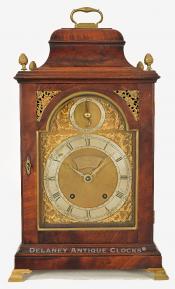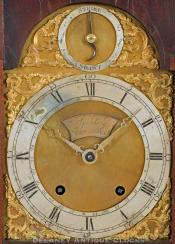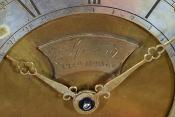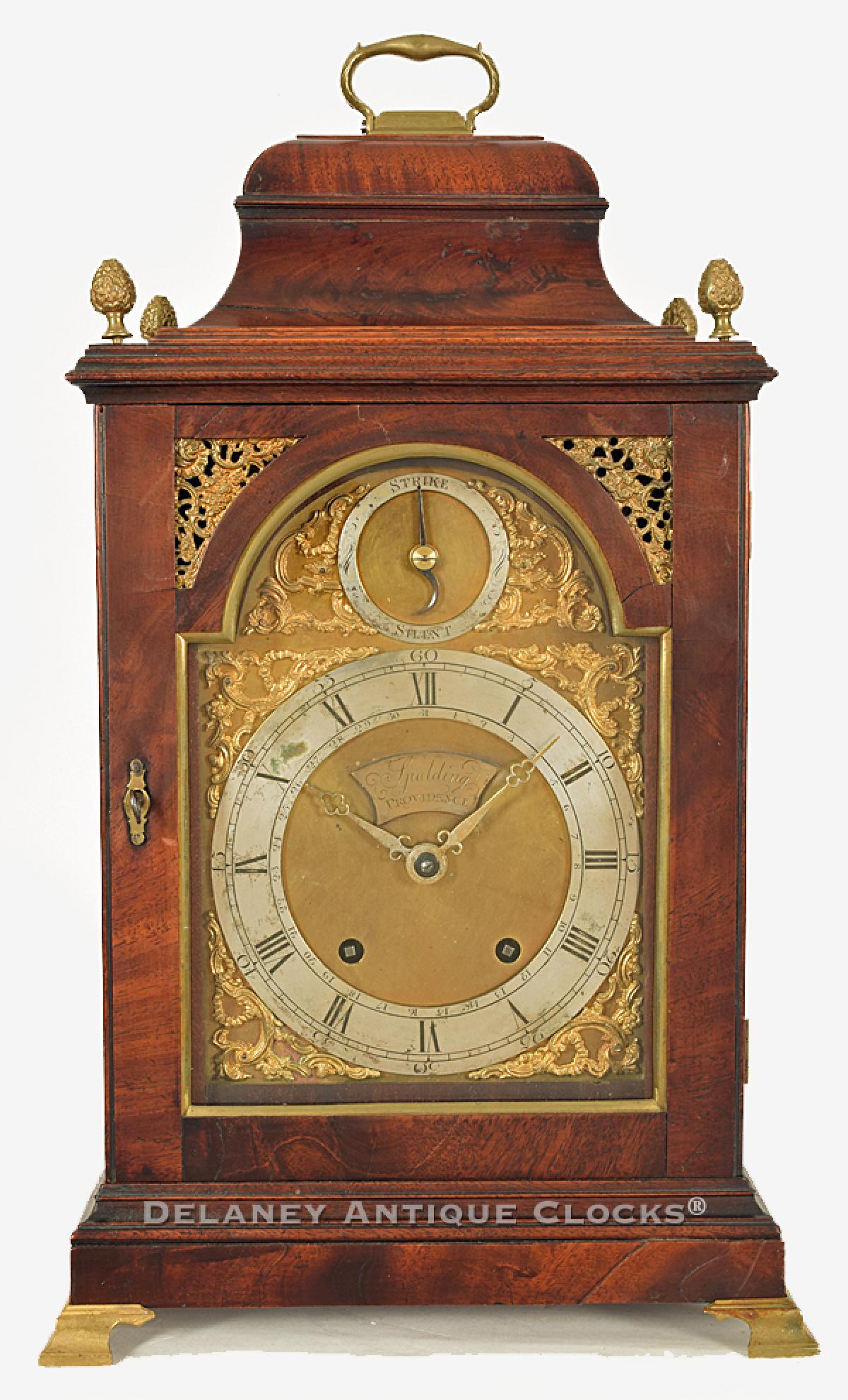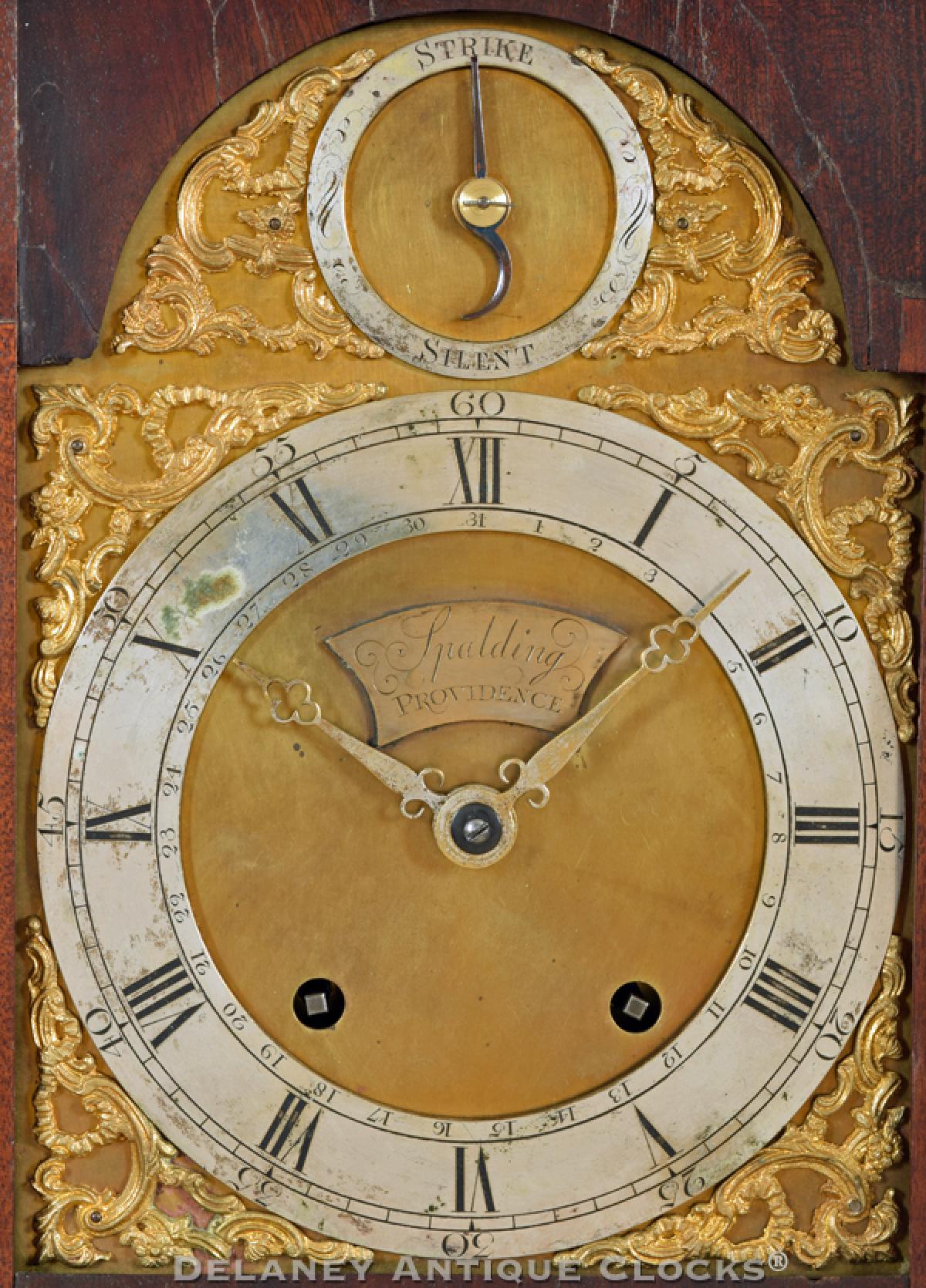A superb American made bracket clock made by the Providence Rhode Island Clockmaker, Edward Spalding. This example is quarter striking. 220013.
This is a rare example of an American bracket clock. It is thought that the vast majority of American signed bracket clocks that share this case form were constructed in England and sold to the American retail market through American Clockmakers, who would sign their names on the dials. This is a fascinating example in that the design and construction of the strike train suggest that Edward Spalding may have had a hand in manufacturing a portion of this very fine mechanism.
This classic case form is veneered in mahogany. The veneers are well-figured, and the orientation of the grain patterns has been strategically positioned for maximum effect. The case is elevated on four cast brass feet. They are nicely formed and applied to the bottom of the clock. Other brass fittings include the two cast spandrels incorporated into the front door's design, the four decorative cast brass finials mounted on top of the case at each of the four corners, and the brass carrying handle. Access doors are located at both the front and back of this case. The doors are fitted with glass. The sides of the cabinet are fitted with shaped openings. These are equipped with red silk and serve as protection from dust and also allow one to hear the striking of the mechanism better.
The front door opens to access the arched brass composite dial. Six cast brass rococo spandrels are applied to the brass base sheet. The lower four spandrels frame the applied and engraved time ring. This is finished with a silver wash, which has slightly oxidized over time. The time ring is laid out from the outside in Arabic five-minute markers, a closed minute ring, large Roman-style hour numerals, and an interior calendar ring. This clock was never fitted with a calendar display. The Clockmaker's name and working location are signed on the applied name plaque. This reads, "Spalding / Providence." The center section is matted. The two hands are brass and wonderfully formed. A Strike / Silent switch is located in the arch or lunette. This allows one to turn the striking train on or off by rotating the hand. This ring is also framed with cast spandrels.
The door at the rear of the clock allows one to view the back of the movement. The heavy brass backplate is skillfully and elaborately engraved in a floral theme. The plates are supported by five-shouldered posts. The movement is secured to the case with brass mounts. This movement is designed to run for eight days on a full wind and to strike each hour on a bell mounted on a stand that is secure to the backplate. The movement is powered by springs and features fusee cones. You will notice that there are two bells mounted above the works. This clock strikes hours as well as the quarter hours. The striking system is complex and uniquely designed, suggesting Spalding made it. The pendulum is constructed with a steel rod and a brass lenticular bob. A steel suspension suspends this.
The approximate dimensions are as follows: the height measured with the handle in the up position is 20 inches, and when measured with the handle down, it is 18 inches tall. This case is 11 inches wide and 6.25 inches deep at the feet.
This clock was made circa 1765.
Inventory number 220013.
Currently, very little is known about Edward Spalding's early life. His parents were Stephen and Marry (Lawrence) Spalding, who lived in Plainfield, Connecticut, when Edward was born there in 1732. It appears that he moved to Providence at an early age and may have trained as a clockmaker in this city. To whom he served his apprenticeship is not currently known. A clock that he is known to have made while working in Providence is dated 1753. This early date suggests that he made this clock shortly after he finished his indenture. It also confirms that he was one of Providence's earliest clockmakers. In 1757, Edward married Audrey Safford. Together they had three children, including Edward Jr., who was born in 1767. Edward trained under his father as a clockmaker. Edward (I) did a fair amount of advertising in the Providence Gazette during the period of 1766 – 1776. These adverisements prove that he was very involved in clockmaking before the Revolutionary War, where he served as Captain and rose to the rank of Major. After the war, he continued to make clocks. He died in Providence in 1785.
Prior to the American Revolution, very few Clockmakers were working in America. The most notable of which from Rhode Island are the Claggetts from Newport, and together they made what is considered a significant number of clocks for the period. Other Clockmakers like James Wady did not fare so well in business. Their output was much less significant, making Spalding the premier clockmaker of his working period in the region.
Several clocks are currently known. One that descended from the Calder family and is now in the collection of the Museum Fine Arts, Houston-Bayou Bend. A second clock originally belonged to Welcome Arnold (1745-1798), Providence, Rhode Island (see David B. Warren et. al., American Decorative Arts and Paintings in the Bayou Bend Collection, (Houston: Museum of Fine Arts.) Two others are pictured in Timeless. Masterpiece American Brass dial clocks.

